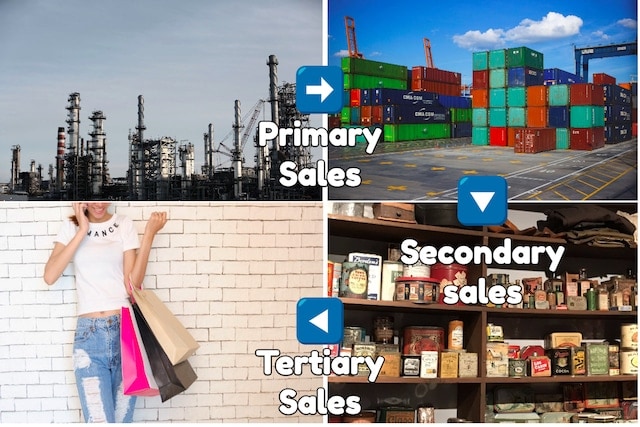Any company which produces goods is concerned with the sale of the goods and movement of goods from the company to the end customer. This movement of goods involves three stages – Primary sales, Secondary sales and Tertiary sales. We will discuss each of them in detail.
Remember that the movement of goods is critical in this concept. Who is selling the goods and who is buying them determines the three level of sales.
Table of Contents
Primary sales
Primary sales happens when the Manufacturer sells goods to distributors. This is the first and primary movement of goods. Here the goods move from the manufacturers warehouse to the distributors warehouse. In many cases, to provide additional support, manufacturers might deliver to the retailers directly. But even in this case, the billing happens to the distributor who is the primary sale point.
How much primary sales happen for a company depends a lot on various factors.
Looking to optimize your sales channels for maximum efficiency?
Quick Tip: Strengthen relationships with your distributors to enhance primary sales. By providing exclusive incentives and consistent support, you encourage distributors to stock more of your products, ensuring better market penetration.
Quick Tip: Focus on retailer engagement to boost tertiary sales. Training retailers about product features and benefits can lead to more effective sales pitches to end customers, ultimately increasing your product’s market share.
- How popular is the company
- How large is the distribution network
- How is the secondary sales (discussed below)
- What is the consumption pattern and hence the refill rate of the product? (Larger products have slower consumption. Example Television vs toothpaste).
Thus, above factors determine the primary sales of a company. Primary sales contributes to the revenue and the profits of the company. Hence, in a way, we can justify that primary sales is the main focus of the company. But primary sales cannot be done without secondary sales. Read further to understand this.
Example of Primary sales – HUL and P&G have a lot of top level distributors who pick the material in huge bulk. The primary sales in this case happens from HUL to the distributor. The more popular the company, the more is the primary sale. Nirma or other such normal brands will never reach the level of primary sales as HUL or P&G.
Secondary sales
Secondary sales happens when the distributor sells to the retailer. In industries where 3 tier distribution is involved, the distributor will sell to the retailer and in this case, secondary sales involves a retailer.
However, in industries where 2 tier distribution is involved, the distributor / retailer might sell directly to the customer. Modern retail works on 2 tier concept, where the primary sale is from the company to the modern retail outlet (Example Walmart) and secondary sale is from modern retail to customer.
The factors determining secondary sales are not much different from primary sales.
- Secondary sales too depends on popularity and brand equity of the company.
- Availibility of stock is more important for secondary sales.
- Aggressiveness of the distributor / retailer plays a major role in secondary sales.
- Credit and trade promotions plays a major role in secondary sales. The better the trade promotions, the more is the sale.
For a manufacturer, secondary sales is more important then primary sale because if the secondary sale does not happen, then primary sale will not happen. However, secondary sales is the responsibility of the distributor and not the manufacturer. So if the distributor is not performing, the company needs to find new distributors who have high performance levels. This will in turn ensure faster movement for the company.
Ultimately, this concept is concentrating on the movement of goods and if any one factor in the chain is not working, then that factor needs to be changed for better efficiency.
Example of Secondary sales – Samsung is known to have distributors who visit retailers to sell the products. In this case, it is the work of the Samsung distributor to ensure stock and display in each outlet. If the retailer has stock, he will sell the product because he wants to liquidate the product at the earliest.
Because Samsung is popular, Retailer may pick more stocks of Samsung and hence the secondary sales is faster. Distributor needs to carry enough stock to fulfil requirement of all dealers under him. On the other hand, HTC which is not as popular, will see lesser secondary movement of stocks and more stock will be lying with the distributor because the stock did not move from distributor to retailer as fast as Samsung.
Tertiary sales
Tertiary sales is the final level of sales observed in a company. This happens when the retailer sells the product to the final consumer. Naturally, Tertiary sales are observed only in cases where there is three tier distribution. For example – If the company has a distributor who is selling to a retailer who in turns sell to consumer.
In fact, industries like Ice cream industry, due to their logistical constraints (ice cream needs to be frozen at all times) might have four tier of distribution. Manufacturer >> C&F >> Distributor >> Retailer. Here the final sale happens when the retailer sells to the customer.
In any case, at the end of tertiary sale the product belongs to the end customer. We can therefore argue, that tertiary sale is the most important sale of all. Companies like Adidas, Apple and others have realised this fact long back. Hence these companies focus more on differentiation so that they can have maximum tertiary sales.
Because the tertiary sales of these companies is so high, automatically secondary and primary sales happen. The factors which drive tertiary sales include
- Convenience – How convenient it is for the customer to buy
- Marketing mix – The 4 P’s of the marketing mix and how they attract to the customer.
- Overall market movement – The faster the market movement or higher the market share, the more is the overall market movement and tertiary movement of the product.
- Brand equity of the company – More popular the company, more is the tertiary sales.
- Presence of alternates – A cheaper alternative or a more higher quality alternative are both challenges to tertiary sales.
Overall, a company which is serious of generating a huge amount of revenue should concentrate on all three levels of sales because together they can drive the best sales for the company. If the company is poor in any one of these type of sales, then it will loose market share to competitors.
Liked this post? Check out the complete series on Sales


